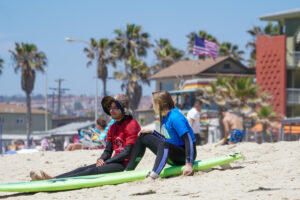Surfing can be considered a safe sport, but like all action sports, it involves some risks. If you are a beginner or an intermediate, we list some of the points that deserve attention to have fun and return home safely.
#1 Collect information about where you are going to surf
Before entering the sea, get some information about where you are surfing. Many beaches have signs indicating restrictions, currents, warning of fishing periods, and even the presence of dolphins or sharks. If the place you are going to surf has no signs, look for a lifeguard or local surfers who can guide you. Having the minimum information already guarantees enough safety.
#2 Use appropriate equipment
It is not any board that is suitable for any day at sea. If the waves are really big, for example, you should not be surfing with a very small board. But there is no use in wanting to go through the break with a longboard, you will not be able to pierce very big waves. So, to minimize difficulties and keep your strength, have the right equipment for every occasion. Thus, the chances of getting hurt will be less. For beginners we always recommend foam longboards, they are light, very floatable and soft, and are great to prevent accidents.
#3 Use and take care of your leash
Leash, strap, string, whatever you want to call the object that keeps the board attached to your body, always use it! It is essential for your safety and the safety of others at sea. Being attached to your board means being attached to something that floats. No matter how much you know how to swim, you never want to separate yourself from the board, it is also a lifeline. Pay attention to the quality and time of use of the leash: if it is old, it can break and leave you in trouble when you need it the most.
#4 Respect the priority rule
If you are starting to surf, you may have a little difficulty understanding the priority rule. It determines who has the preference to catch the wave. Whoever is closest to where the wave is breaking has priority to catch it. You cannot just step in front of someone else. If the surfer is already surfing, don’t paddle to catch the wave. Doing it, in addition to being disrespectful, can be very dangerous.
#5 Attention when jumping off the board
Never jump off the board after riding a wave. You may not remember to check the depth of that spot. So, getting in the habit of diving headfirst can be a big risk. Even when jumping while standing, remember that if it is too shallow, you can hurt your knees, ankles, or feet with the impact. Also, each beach has a different bottom, it can be sand, reefs, rocks. Some of them are more dangerous than others, causing serious injuries. Try to be smooth when throwing yourself off the board.
#6 Bad weather, heavy skies, get off the beach
Lightning strikes are a serious danger and happen more during the summer when the storms hit the beaches. When you’re surfing, the wave becomes the highest point on that strip of the ocean, and a potential target for lightning. So, if the weather doesn’t look good, get out of the water and the beach quickly.
#7 Watch your board
While you do not want to separate from the board, it is also one of the biggest risks of injury. The fins are sharp and can cause deep cuts. And the board itself is a rigid object that can hurt you if it hits you during a broth. To avoid further damage, protect your head with your arms, from the time you fall until you emerge completely. As we stated before, foam boards are a great option for the ones that are learning, it is softer and can prevent injuries like the ones stated before.
If you want to learn more about surfing or try it yourself, access our page to view more content or book a lesson with us. Pacific Surf School is the number one school in San Diego for surf lessons.
Photo by Johny Goerend on Unsplash




